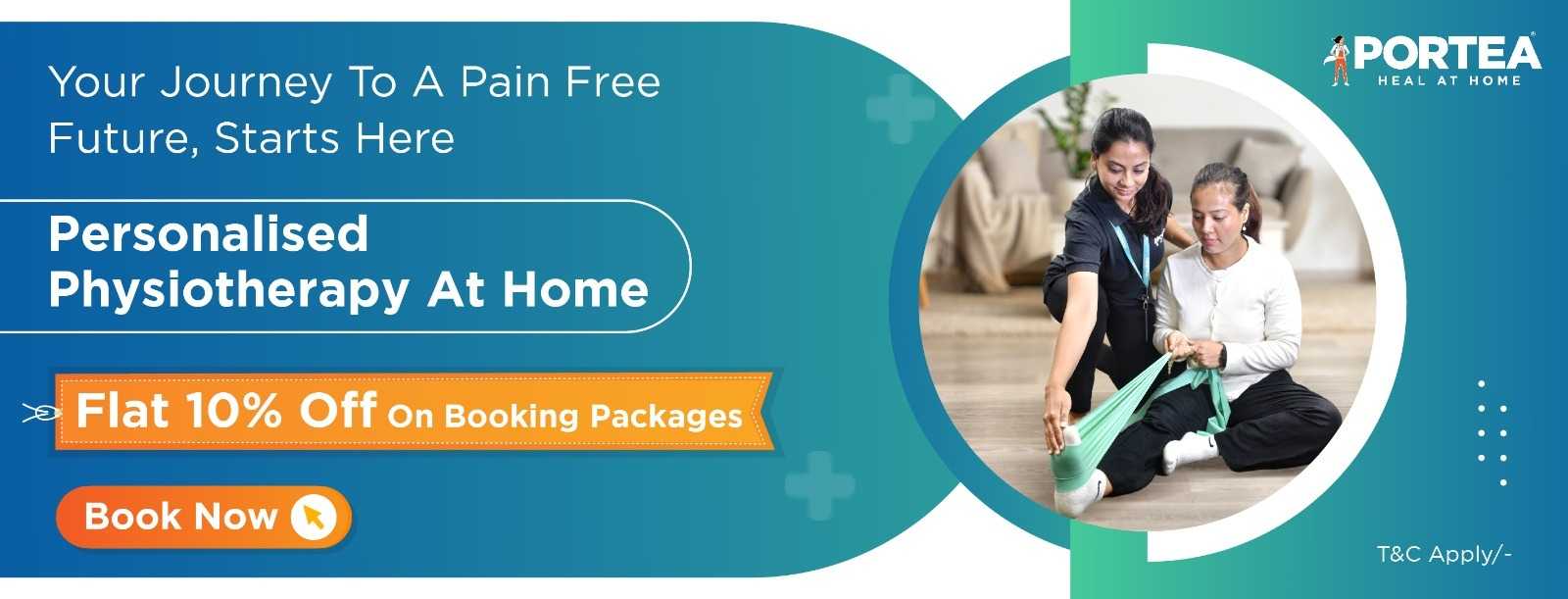
Expert Physiotherapy at Home
Certified physiotherapists visit you at home to provide focused, one-on-one care tailored to your needs. With no travel or waiting rooms, recovery happens in a setting that is comfortable, familiar, and built around your convenience.
Personalised Recovery Programmes
Every treatment plan is designed to suit your condition, goals, and pace. Our physiotherapists follow structured, evolving protocols to ensure consistent progress, with each session aligned to deliver meaningful results.
Trusted Physiotherapists. Real Results.
Our team comprises experienced, background-verified physiotherapists trusted by thousands of families. With a strong focus on safety, reliability, and clinical outcomes, we make recovery at home both effective and reassuring
Patient Testimonials
Portea Physiotherapists for Home Visits
Meet some of our experienced and dedicated healthcare professionals

Dr. Lokesh G
Physiotherapist
Specializations
Experienced in Neurological rehabilitation, Orthopaedic physiotherapy, and Paediatric care
Delivers structured, high-impact treatment plans across neuro, ortho, and paediatrics—ensuring safety, comfort, and measurable recovery at every stage.

Dr. Mohammed Sarwar
Physiotherapist
Specializations
Experienced in Neurological rehabilitation, Adult physiotherapy, and Paediatric care
Combines deep clinical expertise with a compassionate approach, supporting both adults and children through neuro and physical rehabilitation that promotes long-term independence and recovery.

Dr. Nelapati Divya
Physiotherapist
Specializations
Skilled in Orthopaedic rehabilitation, Manual therapy techniques, and Paediatric physiotherapy
Brings a personalised, hands-on approach to healing—combining structural expertise with paediatric sensitivity to restore movement, relieve pain, and improve everyday function.

Dr. Naveen V
Physiotherapist
Specializations
Trained in Pain management, Cardiac and Orthopaedic rehabilitation, Neurological care, and Neural tissue mobilisation
Brings clinical precision and empathy together—designing science-backed recovery protocols for pain relief, nerve mobilisation, and cardio-neuro-ortho rehabilitation across all age groups

Dr. Miloni Savla
Physiotherapist
Specializations
Holds an MPT in Orthopaedics with a focus on Musculoskeletal rehabilitation and strength recovery
Delivers focused, movement-oriented therapy grounded in orthopaedic science—helping patients rebuild strength, restore function, and return to daily life with confidence

introduction
“70% of people experience neck pain at some point in their lives.”
Office workers and computer users are at the highest incidence of neck pain among all professionals. There is an increase in the risk for developing neck pain for people who spend most of their day sitting at work. Duration of computer use, frequency of breaks, method of keyboard operation, position of computer monitors, and type and use of input devices are associated with neck pain at work. Neck pain is common for those maintaining a poor posture with slouched shoulders and head leaning forward. Not long ago, patients with neck pain would have been told to rest or maybe use a neck brace, or would have given a few tablets to pop and wait until the pain had ebbed away. But there is a change in the scenario from the past years about the line of treatment for neck pain. Medical professionals now recommend movement instead of rest.
A study described in Neck and Shoulder Pain, suggest there are mounting scientific evidence for the role of stretching, muscle strengthening and body re-aligning exercises in treating people with neck pain. A short period of exercise can help loosen up tight muscles and bring the body back into proper alignment. Combined with good workplace ergonomics and proper posture, a short daily fitness break in your day could help minimize your work-related neck pain and significantly increase your health and productivity. For example, after a whiplash injury, people heal sooner and are less likely to develop chronic pain if they start gentle exercise as soon as possible. For those with long-term pain (called chronic pain), results from controlled studies show that exercise provides significant relief. In this article we are discussing what to avoid in cervical pain.
taking steps
If you’re interested in using exercise to help relieve neck pain, make sure you get help from a physiotherapist who can create an individualized exercise program based on your pain severity, limitation of movement, and current strength. The program should have clearly stated goals and include stretching and strengthening exercises, as well as exercises to improve how you use your neck muscles. Ideally, if you are working with a physical therapist for cervical or neck pain, he or she will guide you through appropriate exercises, motivating you to work hard enough to see positive results but not so hard as to cause further injury. Before you exercise independently, make sure you understand which exercises to do and how to do them safely. Ask for written instructions and appropriate clarifications if you are still unsure.
HERE ARE THE 5 ‘S’ IN PREVENTING AND MANAGING NECK PAIN THAT CAN BE PRACTICED ON A DAILY BASIS.
- Short break: After all we are humans and not machines who needs breaks at regular intervals. Whether it is sitting in front of a computer or watching television, if you maintain the same position for a long period of time, your neck can get additional strain. This often results in more stiffness and pain. To prevent this, take a break every one hour.
- Stretching: Stiffness and tension in your neck can be relieved through stretching. Start by tilting your head from left to right and hold for 20 seconds on each side. Next, place your hand on top of your head and stretch your neck towards your shoulder on each side. Be sure to perform these stretches with slow, smooth movements.
- Sitting straight: Your muscles are always working hard to hold your head up. But if you are not adopting a good posture, your muscles have to work even harder. Whether you are sitting or standing, make sure that your shoulders are over your hips and your ears are over your shoulders. Try to visualize the top of your head trying to touch the ceiling. You will lengthen and elongate your neck and get as tall as possible. This takes the stress off of your neck muscles.
- Suitable Chair: You need to look for a chair that can provide you with adequate support. It’s best to look for a chair with a back that goes up to shoulder level. With this high-backed chair, your neck and back are kept vertical, and you can lean your head back periodically to give your neck a chance to relax. You may also want to use a small cushion to keep your back in a neutral position.
- Stress management: Studies show that psychological and social issues are important contributors to both back and neck pain. Emotional issues are rarely a cause of neck pain, but they can increase the symptoms of neck pain. Once you identify stress as part of the problem, resolving the neck pain is significantly easier.
Seeking insights to avoid neck pain and its treatment? Experience the ease of Portea’s in-home physiotherapy services. Get test for PAP test and Portea provide nurse care service for cervical cancer as well. For more information or to schedule a session, call us at 1800-121-2323 or visit our website at www.portea.com. Embrace the comfort of receiving expert care in your own home with Portea.
about writer
Rohit Nair
Dr. Rohit Nair is a physiotherapist by profession and has years of experience in treating patients.
faqs
What are the top 5 reasons for neck pain?
The top five reasons for neck pain include:
- Poor posture, especially during prolonged sitting or smartphone use.
- Muscle strain from overuse or awkward sleeping positions.
- Wear and tear from osteoarthritis.
- Nerve compression caused by herniated discs or bone spurs.
- Injuries, such as whiplash from accidents.
Which food is best for neck pain?
For neck pain, foods rich in anti-inflammatory properties are best. Opt for omega-3 fatty acids found in fish, flaxseeds, and walnuts. Include leafy greens, berries, and turmeric in your diet. These foods help reduce inflammation and pain. Also, foods high in calcium and vitamin D, like dairy and fortified cereals, support bone health.
Who is at risk for neck pain?
Individuals at risk for neck pain include those with sedentary lifestyles, particularly those working in desk-bound jobs. Aging adults, due to natural wear and tear of the spine, are also susceptible. People with poor posture or those who frequently use smartphones and tablets are at increased risk, as are those who perform repetitive motions or heavy lifting.
How do you treat neck pain?
Treating neck pain often involves rest, applying heat or cold packs, and over-the-counter pain relief. Gentle stretches and posture correction exercises can also help. In persistent cases, physiotherapy, massage therapy, or acupuncture might be recommended. For severe or chronic pain, consulting a healthcare professional for targeted treatment is advisable.
How physiotherapy for neck pain help you?
Physiotherapy for neck pain focuses on reducing pain, improving movement, and strengthening neck muscles. It involves tailored exercises, posture correction, and manual therapy techniques like massage and mobilization. This approach addresses the root cause of pain, enhances flexibility, and educates on ergonomics to prevent future discomfort and maintain neck health.
Portea offers physiotherapy at home for neck pain. If you’re in need of physiotherapy or any nursing care right at your doorstep, just reach out to us. Immerse yourself in our world-class healthcare services, all from the comfort and safety of your home.
Doctor Consultation
Nursing
Physiotherapy
Trained Attendant
Elder Care
Mother & Baby Care
Lab Tests
Medical Equipment
Speciality Pharma
Critical Care





